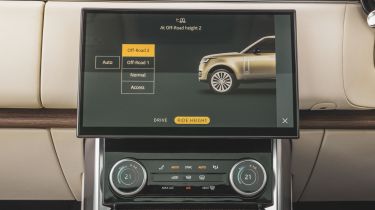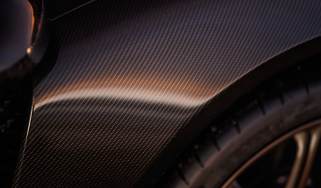What is air suspension? How it works and the pros and cons
Want a magic carpet ride in your car? Air suspension is about as close as you’ll get – we explain what it is, which cars have it and why you might want one

With potholes getting out of control, patchwork repairs, subsidence, expansion joints and all manner of other imperfections on our roads, who hasn’t wished at some point that their car could ride on a cushion of air?
Well, some cars do, if they have air suspension. This technology is a popular fixture in premium cars, helping them to get close to that magic carpet sensation of cruising over whatever horrors the road surface might hold. Yet with modern technology, it’s not like the experience of bouncing around on an air bed either – these days, you can have both a smooth ride, and also composed handling.
It sounds great on paper, but what actually is ‘air suspension’? Below we explore what the technology is, how it works, what cars tend to come with air suspension, and some of the advantages and disadvantages of riding on air in your car.
What is air suspension?
Air suspension is a means of using pressurised air to replace the conventional coil springs used in a vehicle to absorb imperfections in the road. Just as a coil spring compresses in response to a bump, air in an air chamber does likewise – but with less of a mechanical link between the vehicle and the road surface. Air suspension can theoretically cushion bumps better than a coil spring, as air should absorb a wider range of bump frequencies and amplitudes than a metal spring.
The technology has been around since the early 1900s and is widely used in trains, trucks, and buses, but has also been popular in high-end cars since the late 1950s. Air suspension tends to be standard fitment on modern luxury cars – often with some kind of adaptable functionality, allowing for changes in spring rate, ride height, and more so drivers can adjust the way their car feels.
You might also have heard of air suspension as a car modification. Here, the concept is taken to the extremes, where a car’s conventional springs and dampers are swapped out for a custom setup which can be controlled from inside the car. It’s primarily done to achieve a certain look with a modified car – and that look tends to be as low as possible, dropping the car down so its chassis is almost (or actually) sitting on the ground. Of course, it’s difficult to drive like that – so the driver can raise the suspension back up to a somewhat practical level for actually driving around.
How does air suspension work?
At its simplest, air suspension takes the form of just four ‘air bags’, sometimes called air springs or bellows, one for each wheel. These are located in the place you’d normally find a conventional spring and damper. On a practical level, air suspension works much like a coil spring does. Air is compressible, so when a wheel hits a bump, the air absorbs, but also resists, the motion.
Generally though, there’s a little more to it than that. There will also be air tanks in the car, which are connected to each air bag by air lines and via valves, letting air flow in and out at a controlled rate. These will also typically have electronic control which can adjust air pressure on demand. This system, in turn, will talk to one, or several of a modern car’s ECU computers to adjust depending on various factors. These factors may include user control (such as switching between driving modes), or through clever technological features (such as the suspension of a low-riding saloon raising to make it easier to get into the car).
Like a coil spring, it will also typically rely on another device for damping properties, to prevent the spring rebounding and compressing continually. Many modern cars using air suspension have the air bags as part of an integrated unit with a damper, and both will be controlled electronically to adjust both spring and damper rates.
What cars offer air suspension?
Air suspension is a common fixture at the top end of the market. You’ll find it’s standard on cars such as the Mercedes-Benz S-Class, Range Rover, BMW i7, and of course all Rolls-Royce models. It’s also optional on cars like the Mercedes C-Class and E-Class, Volvo XC90 and Audi Q5, depending on trim level. In addition, air suspension is often used for the rear axle only specifically on larger estate cars such as the BMW i5 Touring, as it can provide self-levelling for heavier loads in the boot. Most of the predecessors of the cars mentioned above offered air suspension in one format or another too, stretching back several decades.
Air suspension hasn’t generally been offered on less expensive cars, though if you want air suspension-style ride quality from a more affordable model using different technology, then old Hydropneumatic Citroens (which used a combination of nitrogen and a hydraulic fluid), and Hydragas MGs and Rovers (such as the MGF and Metro, which is similar to Citroen’s system but has no active element) are as close as you’ll find.
What are the advantages and disadvantages?
Given that air suspension tends to be either standard or at least optional on higher-end vehicles, you could say that one immediate disadvantage is that the technology isn’t particularly accessible for the average consumer – it’s very much a premium product.
It never stops being a premium product either, as anyone who has had to repair or replace air suspension on an older luxury model will confirm. Air suspension has the potential to operate for longer than conventional springs and dampers, but when it does fail, or the electronics around it fail, it’s also a lot more expensive to deal with. You’ll no doubt be familiar with the sight of old Range Rovers and Mercedes S-Classes hunched down over their wheels like a scolded pet…
However, there are plenty of advantages too. One is simply ride quality, as in theory, a car riding on a cushion of air should do so more smoothly, and allow fewer imperfections through, than coil springs. While it’s not an improvement in every scenario (certain bump frequencies can catch out air springs, and the huge wheels and tyres on modern luxury cars give them a lot of mass to control), air-sprung cars do tend to ride better than an equivalent car with a more conventional setup.
Air suspension technology also allows for huge adaptability. The most common one is ride height adjustment, allowing a car to raise for certain types of terrain or for easier access and exit. It can then lower at motorway speeds to improve aerodynamics. Some systems get even cleverer: Mercedes equipped with Magic Body Control air suspension could tilt a car down into a corner to counteract centrifugal forces on occupants, while Audi’s Predictive Active Suspension could quickly raise one side of a car prior to a side impact to make better use of side impact protection systems.
And of course, there are other adaptable functions, such as changing spring and damper rates between comfort and sport functions, to a greater degree than is possible simply through adjusting dampers in a car with coil springs.
Our Car Tax Checker tool lets you check your tax status and renewal date in seconds. Check your VED car tax now...
Find a car with the experts





